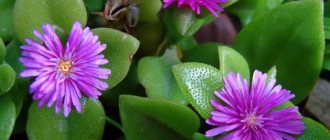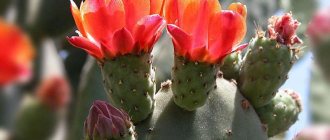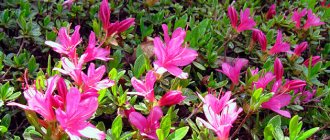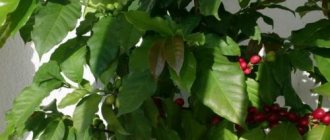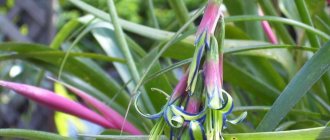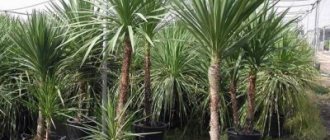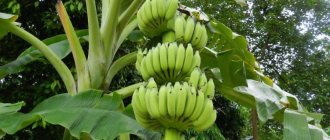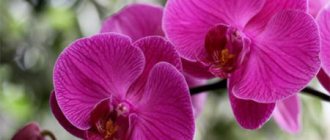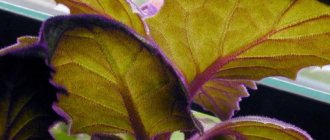Cycas, also called sago palm, cycad, belongs to the Cycad family.
This family includes about 20 plants, but the cycas stands out among all, primarily because it is the most ancient crop. Its remains were discovered back in the fourth geological period of the Paleozoic era, that is, more than 300 million years ago! The south of the Asian continent, Australia, is considered its historical homeland. Currently, cycas also grows in Russia: in Sochi they grow well in open ground, in regions with a harsher climate, with proper care, they are easily grown at home.
Description of the sago palm
The main decoration of the cicada is the long feathery leaves of a rich, bright green color. This is a dioecious plant. Female specimens are distinguished by reddish or yellowish pubescent leaves against a background of bright greenery. Male cycads form knobby projections – microstrobilae – at the base of the trunk.
Important! In home cultivation, only female specimens are used, since male microstrobili have a very unpleasant odor.
Cycad seeds ripen in cones that usually form on the upper part of the trunk of female plants. These are loose formations that consist of modified young leaves. The ovules are located on these leaves. However, you should know that cycas does not produce seeds under indoor conditions.
When grown wild in subtropical or tropical conditions, the cycas grows up to fifteen meters in height. Houseplants usually grow to a maximum of 150, more often up to 50-80 centimeters.
The sago palm grows very slowly - no more than 3 centimeters per year, and rarely produces new leaves - up to three per year.
The leaves grow from the central part of the trunk, covered with brown scales - remnants of the bases of dead leaves. A powerful vein runs through the central part of the leaves, which has no branches. Segments of young leaves are usually curled like a snail, but over time they straighten out. The lifespan of the leaves is up to three years.
Cycas is also characterized by a very thick trunk, although in home growing conditions it develops rather poorly.
Description of popular varieties
Washingtonia palm - home care
The exotic cycas palm comes in various types and shapes; few are suitable for home cultivation. The best option is considered to be Tsikas curled and Tsikas Revoluta.
Cycas curled or snail-shaped (Cycas circinalis)
The height of this type of palm tree reaches 3 meters. The leaf blades grow up to 2 meters; as a rule, they are collected in bunches of several pieces. While the leaves are young, they are directed straight up, but as they mature they are placed in a horizontal position.
Cycas curled or snail-shaped
Separate leaf blades contain 50-60 densely arranged green leaves, lanceolate in shape. The length of the leaves reaches 25 centimeters; their width, as a rule, is no more than 1.5 centimeters. The change of leaves occurs very quickly: the old foliage falls off and only the young remains.
Cycad drooping or Cycas Revoluta
The Cycas revoluta palm tree is native to Southern Japan. The plant has a thick columnar trunk up to 3 meters high. The trunk diameter is about a meter. The odd-pinnate leaf blades grow up to 2 meters long. The plates usually consist of many light green, slightly curled, narrow, leathery leaves. Young leaves are slightly hairy, but as they mature they become bare, dark and shiny.
Cycad drooping or Cycas Revoluta
Male bushes have narrow cylindrical cones up to 80 centimeters long and up to 15 centimeters in diameter. Female bushes have loose, light red, fluffy cones. Cicasa Revoluta care at home involves providing the plant with sufficient light and moderate watering. The indoor palm tree Revoluta grows very slowly - it can grow no more than 3 centimeters per year, so you should be patient.
The sago palm looks very original in a pot, which can bring a bright touch of the tropics to the room. The plant does not grow very quickly, it may not bloom, but if all the rules of care are followed, it will decorate any home for many years.
Origin of the cycad
Cycas is a plant from the tropics and subtropics; Australia and the countries of Southeast Asia are considered its homeland. It is believed that this particular plant to some extent became the progenitor of modern spruce trees, as well as ferns and horsetails.
Interesting! Cycas is such an ancient plant that we can safely say that representatives of this genus were closely acquainted with dinosaurs.
It is believed that such longevity of this species in an almost pristine state is due to a rare ancient symbiosis of five different organisms: the cycad itself - the host, a fungus, two types of bacteria, as well as blue-green algae.
The distribution area of the cicada is extremely wide - it does not grow in open ground only in northern Europe and Antarctica. At home, it can also be grown beyond the Arctic Circle.
Description: appearance, trunk, leaves, features
Cycas is classified as a coniferous plant. Its appearance resembles a palm tree due to its spreading crown.
A powerful trunk with a diameter of 20-80 cm reaches a height of 7 m. Its bark resembles a shell. Indoor cicadas grow slowly: 1-2 branches of leaves appear per year. They are distinguished by elasticity and immunity to the environment. The flower is unpretentious to care for at home.
The plant has hard leaves that appear simultaneously in the lower part from a downy rosette. At the beginning of the formation they resemble the unfolding fronds of a fern. Within 1-2 months they become leathery and tougher. Once they reach the reproductive stage, the semi-glossy leaves take on highly arched shapes.
Cycas is a bisexual plant. You can distinguish a male from a female by the bump. She appears at the top. In a female specimen, the cone resembles a cabbage; large, dark red seeds ripen in it. Pollen is produced in the male.
Cycas is a poisonous plant. Toxins contained in flower parts cause severe poisoning if they enter the stomach. The decorative flower should be placed in places inaccessible to children and animals.
Cycas: types and varieties, photos
The plant is currently represented by a little more than twenty species, among which the most common are C. curled, C. drooping (turned away), C. comb-shaped, C. media, C. non-thorny, C. Rumpha, C. Tuara.
The most popular is the drooping cicada, or turned away, also known as Ts. revoluta. Thanks to its lush, but at the same time very compact crown, it has become a real favorite of designers who use it for indoor landscaping. It is very often found in gardens and parks of the tropics and subtropics. The following varieties of drooping cycas are especially loved by flower growers:
- diplofoliolum with forked, double-pinnate leaves, creating the effect of an extremely lush crown;
- corrugata - a very rare, but very decorative variety with striped leaves and a bottle-shaped trunk;
- alba, or golden cicada, notable for the pale yellow color of young, barely blossoming leaves, which gradually changes to a rich green color;
- variegata is the most popular among variegated varieties.
Other types of cycas are much less common in indoor floriculture, mainly due to the high demands on living conditions, as well as due to the fact that their sizes are not suitable for indoor spaces.
How to choose the right place for a flower
Since illumination primarily affects the normal growth of the cicada and its development, the place for it must be selected with special care, no matter what time of year it is outside the window.
Important! The duration of daylight hours for cycas should not be less than 12 hours. Therefore, choose the brightest room for the plant and place it near the window.
The best option is south-east or south-west windows. At the same time, it is important to organize additional lighting during the period when there will be a lack of natural light.
If the plant does not have enough light, its leaves will not fully develop, will turn yellow early and fall off. Also, the lack of light affects the growth of the cycas: it stops growing.
In the warm season, it is advisable to take the pot with cycad out into the open air. At the same time, unlike most house plants, it is not at all afraid of direct sunlight, although it needs to be accustomed to it gradually.
Important! Cycas is poisonous; when determining a place for it, it is necessary to ensure that it is inaccessible to children and pets.
Average
If you see a cycad in the park with leaves curved in the form of an arc , you are clearly looking at an average cycad. It is of Australian origin and is perfect for landscaping public gardens and other public recreation areas. The leaves are long - up to 7 meters, growing in the form of a rosette on the top of a thick trunk. The male tree has medium-sized cones (no more than 25 cm), while the female tree looks like bunches of ears of corn and is even smaller.
Residents of Northern Australia ate cycas seeds, having previously been subjected to heat treatment: they contain poison that repels birds and insects
Tsikas Medium
Substrate, watering and feeding of cicada
Cycas has no special requirements for the substrate. Standard soil for palm trees suits it perfectly. The mixture is made up of turf and leaf soil, peat and sand, taken in equal quantities.
It is recommended to add a small amount of humus, charcoal and fine pebbles, within 20% of the total composition. Such a substrate will most fully correspond to the soil in which cycads grow in nature.
The growing container must be sized to match the volume of the roots - it is 2-3 centimeters larger in diameter to allow the root system to develop.
Any pot for cycads will do, ceramic or plastic - there is no difference. The only thing you should consider when choosing is that moisture evaporates less in plastic pots, so you need to water the plant in it less often than in ceramics. But the clay container is heavier, which means it is more stable. This is especially important for large plants.
Important! The drainage layer is poured at least 3 centimeters. Expanded clay, crushed brick or medium-sized pebbles are usually used as drainage. An important condition is the presence of drainage holes.
The cicada requires rare but plentiful watering. In summer it is watered once every 5-7 days. In winter, watering is more rare - once every 10-12 days. Cycas tolerates drought better than excess moisture. Therefore, after watering, the water from the pan must be drained. Water for irrigation should be at room temperature, soft, and well settled.
Cycas are fed from early spring until mid-autumn once every 15 days. In the autumn-winter period, fertilizing is carried out once a month; you can completely do without it.
Fertilizers designed specifically for palm plants are used. Mullein diluted with water 1:20 is used as organic matter. The cycad also accepts horse manure diluted in water well.
Important! Fertilizers containing calcium or magnesium are not suitable for cycads.
Cycas (Sago palm): description, photo, home care
Cycas is a spectacular house plant, also called sago palm.
This plant likes to be capricious and can even shed its leaves if not properly cared for. My first cicada almost died because when watering I did not take into account that its trunk does not like moisture. My wonderful palm tree almost rotted. After that, I studied all the nuances of caring for the cycas and will be happy to share the information with you in this article.
Meet the sago palm
Cycas revoluta is not a very common houseplant. Its appearance is very interesting - from the trunk, which is a large cone, long, powerful green leaves grow, similar to bird feathers (a typical leaf shape for a palm tree).
I repeat once again: caring for the cycas at home assumes that moisture will not get on the cone (trunk). It is important!
The homeland of the houseplant is South Asia and Japan, so it loves warmth and moisture, while being a rather capricious houseplant. For example, it does not tolerate direct sun rays well in the hot summer months (despite its love for warmth), and at the same time it can get sick due to frequent ventilation in winter.
Cycas revoluta is a large plant and requires a lot of space, as its leaves are very spreading. You need to think carefully about where it is better to place the sago palm, and what plants can keep it company on the windowsill.
It is possible that it is best to leave the cycas all alone, so it will be more comfortable, and its spreading leaves will not obscure the light of other plants.
The palm grows very slowly, the leaves reach a length of 1 m. In general, the plant usually reaches a height of one and a half places. Its life cycle is very long, so the plant lives for a very, very long time (in natural conditions for more than a hundred years, but at home it is also a long-lived palm tree).
Sago palm – lover of light and moisture
Place the cicas in the southern part of the house. There. Where there is more light and warmth, because the sago palm is a southerner, it loves sunlight! At the same time, in the summer, when the light becomes scorching, it is better to shade the window on which the cycas is placed so as not to get burns on the leaves.
You can move the palm tree to the balcony (especially if the balcony is glazed and it is possible to protect the leaves from burns).
Of course, if you have the opportunity to monitor the plant during the day, then you can simply take it out into the air closer to the afternoon, when it is better to lose its intensity, because the palm tree loves fresh air and will be grateful to you for timely air baths and will turn green more luxuriantly.
In winter and in the off-season, the palm tree should not be moved to cool rooms - it may freeze.
In winter, it also rests, but still does not require such low temperatures as some house plants like in the cold season. The sago palm is comfortable at a temperature of +20 degrees.
It prefers high humidity, so it is recommended to spray it regularly, about once a week, carefully covering the cone from moisture (the spray should only fall on the leaves themselves). Also, when watering, you should be very careful not to allow drops of water to get on the pine cone.
Water the cycas very carefully and carefully! It should also be remembered here that the sago palm does not tolerate drying out of the soil at all! You risk losing the plant. That is why it is necessary to monitor soil moisture all the time. It should be slightly damp. As soon as dryness appears, the plant should be watered.
During the summer, water your palm tree about once a week. Be sure to take water at room temperature! Cycas does not tolerate cold water. It would also be good for the water to settle. The sago palm prefers clean water.
Soil requirements for cycas
If you bought a cycas in a store, then, as a rule, the pot contains the right type of soil. If you want to replant it in another pot, then you should not take a universal soil mixture; it is better to look for a special soil for palm trees. In this case, there is a guarantee that the cycas will grow well.
It is important that the soil is loose and contains turf, peat and sand. Drainage is required! The composition of the soil is as follows: 2 parts each of turf and leaf soil, plus one part each of peat and sand.
Take care of your plant, its health is quite fragile! Before planting a palm tree, take care to disinfect the soil.
You can, for example, keep the prepared soil in the oven at 200 degrees for half an hour, then cool. In this way, all harmful and even dangerous microorganisms are killed in the soil.
A young sago palm should be transplanted into a larger pot every spring for the first five years. Then the plant will begin to grow more slowly, so you can replant it much less frequently (once every four years).
When replanting, it is important to fulfill the following requirements: replant very carefully, do not shake off the roots from the old soil (they like to be completely exposed). The cone should rise slightly above the surface of the soil.
Feeding and reproduction
With the arrival of sunny days, the palm tree begins to grow. At this time (starting in the second half of spring) it is better to feed the cicada. And he will answer you with high-quality growth of green mass.
Feeding should be done until the very end of summer, twice a month. In flower shops you can find special fertilizer for palm trees. It is better not to use universal mixtures. You can also use simple and readily available cow dung. All plants love it!
Cycas propagation is not very difficult. He periodically produces babies: they are easily separated and take root well with proper care. Look carefully: on the cone (trunk) of the cycas there are usually young shoots that look like bulbs. You will need them for reproduction. The ideal time for breeding is the second half of winter.
Source: https://sornyakov.net/komnatnye/cikas.html
Conditions for keeping a cycad
Like all tropical and subtropical plants, cycas loves warmth. However, it is very hardy and can survive short frosts, although with some loss of decorative value. It does not have a pronounced rest period, but during the season of short daylight hours it is advisable to organize a lower temperature for it - 15-17 degrees.
Cycas is not particularly demanding of moisture. However, a level of 70-80% is considered optimal. If the air in the room is dry, which is typical in winter, the containers with the plant are placed on a tray with expanded clay or pebbles, which are periodically moistened. You can also cover the soil in the pot with a layer of moss.
It is periodically necessary to remove dust from cycas leaves, since contaminated leaves are more likely to be attacked by pests. Usually, to maintain cleanliness, the leaves are sprayed with warm water.
Important! When spraying leaves, you must ensure that water does not get on the trunk.
Cycas should be protected from drafts, as they can cause yellowing of the leaves. The plant will also benefit from pruning leaves that have lost their decorative properties due to their age or damage by diseases and pests. A leaf dying due to natural reasons stands out among its fellows by its strong slope towards the ground.
What to do if it turns yellow?
There may be several reasons for the appearance of yellowness:
- Excess or lack of moisture: this is how a capricious cicada gives you a signal that you are filling it up or, on the contrary, not feeding it enough. Remember: if it’s hot in the apartment in winter, then you can’t reduce the volume of water. But you also can’t pour so much water into the pot that dirt forms there: the roots will begin to rot, and then the leaves will turn yellow.
- There are not enough nutrients: the cycas may either shed its leaves or turn yellow. So don't forget to feed the plant on schedule.
- The wrong place is chosen: in a room with musty, stagnant air, not only you, the person, but also your plants will get sick. Lack of ventilation and fresh air leads to a change in the color of the leaf plates.
- Pest attack: spider mites and scale insects love to settle on cycas, and one of the signs of their presence is the yellowing of the leaves. Pests can be collected manually, and then wash the plant in the shower and treat it several times with a suitable preparation “(Actellik.” “Talstar”, “Neoron” “Apollo”).
How does a cycad reproduce?
Reproduction by shoots
If normal conditions are created for the cicada at home, fully complying with all the rules, it periodically forms shoots (offshoots) from the trunk.
Important! The procedure is carried out very carefully to prevent damage to the trunk of the mother plant.
The process of separating the offspring is as follows:
- The plant is carefully removed from the soil.
- The offspring is separated with a sharp disinfected instrument (scalpel or knife). At the same time, the condition of the root system is usually checked.
- After separating the shoot, it is necessary to treat the cut on the main trunk with crushed charcoal or cinnamon powder.
- The leaves are carefully removed from the cut shoot, the cut is treated with an antifungal drug, then with a root formation stimulator.
- The offspring is planted for rooting in well-moistened coarse sand or coarse perlite. At the same time, it is buried approximately three-quarters of the size of the cone.
- Until complete rooting, the container with the shoot is kept at a high temperature - about 30 C - in a slightly shaded place. Important! The substrate must be constantly moistened.
- During the first week, the shoots require watering every 2-3 days. Then watering is reduced.
- Cycas shoots take a long time to take root, up to six months; some varieties require 8-9 months. The offspring is carefully transplanted into a standard substrate for cycads when its roots grow and become stronger.
Propagation by seeds
This method is little used for home cultivation, since it is quite difficult to obtain cycas seeds; the plant blooms in adulthood, when it is over 50 years old. It is more suitable for greenhouses or open ground.
However, in recent years, it has become possible to purchase cycad seeds from online stores or brick-and-mortar seed stores.
In this case, the seeds are first soaked in warm water for 24 hours. After soaking, they are laid out on a layer of perlite or well-washed coarse sand, slightly pressing them into the substrate.
Seeds take a long time to germinate, the process lasts two, usually three months. When the seedling forms its first true leaf, it is transplanted into the soil required by the adult plant.
Replanting instructions after purchase
Cycas flower - how to care for a sago palm
A cicada bought in a store is given two weeks to take root in the house, then it needs to be replanted.
Important! If young, unformed leaves are visible on the plant, it cannot be replanted. The plant may stop growing for a long time. You should give the cycad a chance to grow leaves, and then start replanting.
Procedure for transplanting cicada:
- Carefully remove the earthen lump from the commercial container.
- Inspect the root for damage and disease. If rotten, dry areas are found, they are cut off and the cut is treated with a fungicide.
- The new pot should be slightly larger in volume than the rhizome, but not more than 2 cm.
- Organize high-quality drainage at the bottom of the pot from old shards, expanded clay, pebbles, and shell rock.
- Cut off the bottom row of old leaves.
- Place the root system with a lump of soil in a new container.
- Sprinkle with earth and press down.
- Water the flower a day after planting.
- If the ground has settled, add more.
Note! For some time after planting, you need to monitor the condition of the flower and do not expose it to bright sun.
Proper planting is half the success in growing
Cycas transplant
Cycas is one of those plants that do not particularly favor transplantation, since their roots react painfully to shocks of this kind. However, at a young age it is recommended to replant it every two or three years.
More mature plants, older than 5-6 years, are replanted only if it becomes obvious that the roots in the pot are crowded, usually every 5-6 years. The need for replanting will be indicated by roots protruding through the drainage holes.
The pot for replanting is selected so that its diameter is 2-3 centimeters larger than the diameter of the trunk. The depth of the pot should be 2-2.5 times the diameter. For example, if a container with a diameter of 15 centimeters is required, its depth must be at least 30 centimeters.
It is believed that any season is suitable for transplanting cycas, but preference should still be given to the spring period, before active growth of the cycad begins.
Important! Cycas are not replanted while new leaves are forming.
Before transplanting, about a third of the leaves are removed from the plant, cutting off the oldest ones first. The root system requires special attention when replanting, since deformation of the roots or their breaking off, especially thick ones, can lead to putrefactive diseases.
The plant is replanted by transshipment, without affecting the earthen lump surrounding the roots. It cannot be shaken off or washed off.
Description of the flower
Cycads can reach a height of 15 m. At home, the flower grows just over half a meter tall. The annual growth is only 3 cm. Outwardly, it is similar to a palm tree due to a single trunk topped with a cap of feathery leaves. Young leaves unfurl in a snail shape, like those of ferns.
Tsikas will decorate any interior
In 12 months, a cycad can grow only one layer of leaves. Young leaves are soft, covered with fluff, they are bright green, but with age they darken, become hard and glossy.
For your information! The cycad is a dioecious plant and can only reproduce by cross-pollination. Houses of sporangia and megasporophylls are rarely formed.
The lifespan of a cycad can be up to one hundred years.
Cycas pests
The scale insect settles on the leaves, sucking the juices from them. The leaves first turn yellow, then begin to dry out and fall off.
Spider mites appear when the air humidity is too low, entangling the leaves with a thin web. The leaves also lose color, dry out, and fall off.
Thrips inhabit the lower parts of leaves; their appearance is also associated with insufficient air humidity combined with low temperature. Whitish dots and small spots appear on the leaves. Then the leaf acquires a light brown color with a silvery coating.
The preferred means of combating these sap-sucking insects are folk ones - a solution of laundry soap, zoo shampoos, infusions of garlic or onions. Plants are treated several times at intervals of 5-7 days, picking off pests manually whenever possible.
If traditional methods do not help, you have to resort to treating plants with chemicals - Actellik, Fitoverm, etc.
Mealybugs also appear on plants at low humidity, especially during the off-season. Often its appearance is provoked by the accumulation of dust on the leaves. The scale insect is recognized by the appearance of white sugary formations.
Important! Causative agents of sooty fungus often settle on mealybug secretions.
It is best to remove scale insects manually using cotton swabs soaked in vodka or a solution of laundry soap. If the pest colony is too large, it is recommended to use preparations based on imidacloprid (Biotlin, Iskra, Tanrek, etc.).
In this case, treatment is carried out weekly for one and a half months.
Pests and diseases
Why do the leaves turn yellow?
Cycas leaves may turn yellow for several reasons:
- due to a lack of microelements,
- due to lack of nitrogen,
- due to injury to the roots, their hypothermia,
- due to improperly organized lighting.
What to do if the leaves turn yellow? Try to make every effort to save the flower. Water it only with water at room temperature, review the fertilizer schedule, and move it closer to the light. If these measures do not help, replant in fresh soil .
Rarely, but it happens: the leaves turn yellow due to the fact that the flower is moved outside in the spring without first hardening it off.
What to do if the leaves dry out?
When the leaves dry in the lower part of the plant, this is a natural process. However, if all this happens quickly, from the tips, the reason lies in the air humidity being too low.
The following pests settle on the cycas : scale insects, mealybugs, aphids, herbivorous mites.
Shchitovka
The scale insect tightly adheres to the entire plant - from the crown to the root, laying larvae on the back of the leaves.
A characteristic feature of the pest is a dense protective covering on the body. The leaves begin to turn yellow, dry out and curl, and fall off over time. A sticky liquid is visible on their surface.
Control method: remove adults with a cotton swab dipped in soapy water, then wipe the leaves with tobacco solution or garlic broth. Let the mixture dry, wash the flower in the shower and treat it with an insecticide (Confidor, Tanrek, Actellik, Inta-vir, Karbofos). Carry out the treatment early in the morning or in the evening, at an air temperature below +30 degrees .
Aphid
Aphids rarely appear on cycas. The first sign: the leaves begin to curl into a tube. Taking a closer look, it is easy to notice many small holes on the plates and small (no more than 3 mm) green or white insects. As individuals grow, it forms many dense growths on the shell. A disease called sooty fungus gradually develops.
It feeds on sap, which weakens the plant and leads to death. Control methods: wash off the sticky coating from plants in the shower, spray with infusion of citrus fruits, baking soda or tobacco. By the way, mint leaves placed near the pot will help drive away aphids - they cannot stand the mint smell. Preparations: “Aktara”, “Tanrek”, “Iskra”, “Fitoverm”, “Trichopol”.
Mealybug
Mealybugs, like other pests, feed on cell sap.
Leaves honeydew (honeydew) on the plant, which is a favorable environment for the development of fungal diseases. It damages not only the above-ground parts, but also the roots, so it is often impossible to save the affected plant . It is better to change the soil in the pot. Wipe the plant with a solution of green soap, then spray it with a decoction of cyclamen, infusion of tobacco or onion (with an interval of 7-10 days). Afterwards, treat with a special preparation (“Admiral”, “Aktara”, “Aktellik”, “Bankol”, “Biotlin”, “Inta-vir”, “Fitoverm”, “Tanrek”).
Herbivorous mites
Herbivorous mites settle on all surfaces of the cycas. A warm shower followed by treatment with Vermitek, Kleschevit or Fitoverm will help get rid of them.
Don’t forget to treat the place where your cicas stood with a soapy solution, and also wash the curtains.
Cycad diseases and their treatment
The most dangerous diseases of cycads are rot of the root system or trunk. Putrefactive lesions are caused by fungi.
To heal a plant, first remove it from the pot, carefully wash the roots with warm water and carefully examine it.
Important! If the trunk or roots are affected by rot at a level of 70% or higher, it will no longer be possible to cure the cycad.
Partial lesions are removed with well-sharpened sterile instruments. Decaying areas are cut out to healthy tissue, which is light brown in color. Then the cleaned areas are sprinkled with crushed charcoal or activated carbon and left to dry for several hours.
Roots affected by rot are darker in color than healthy ones. They are also soft to the touch and do not have small secondary roots. All affected areas are cut out, then the roots are placed in an antifungal solution. After soaking for half an hour in the fungicide, the roots are treated with a root growth stimulator, and the cut areas are filled with wax or candle paraffin.
After these procedures, the plant is planted in a small pot. Clean coarse-grained sand is used as a substrate, which is pre-disinfected by steaming or calcination.
As a rule, the recovery period for a cicada lasts up to six months. All this time you need to carefully monitor the plant in order to repeat the treatment in time if the need arises.
Important! During recovery, the cycad often sheds its foliage, which during this period takes away from it the strength required for a complete recovery.
The aboveground part of the cycas affected by rot in most cases leads to the death of the plant. Therefore, you can only try to save the lateral processes that can be rooted.
Leaf spot is a less dangerous disease of cycads. It occurs due to violation of plant care rules: lack of fertilizing, drafts, low humidity, excessive watering. Treatment in this case consists of restoring the regimen of all care activities.
Cycas palm: care and cultivation for beginner gardeners
Lush ornamental plants in a home or office serve as a real decoration and an ideal addition to any design. Most often, this role is played by a variety of palm trees or plants similar to them.
The cycas palm is one of the most beautiful decorative additions to the premises, which is also quite unpretentious in care and is perfect for growing at home even by inexperienced gardeners.
- Description of the cicas palm
- Cycas palm: care and cultivation
Description of the cicas palm
By appearance, even without knowing the name, you can immediately determine the type of origin of the plant, because its leaves are large feathery fans, which are characteristic of palm trees. Experienced gardeners are happy to keep this plant in their home garden, and in the summer it feels great on the streets, for example on balconies, terraces or garden plots.
Sago palm is the name of the plant most often heard in flower shops. At home, it grows no higher than 50 cm, but in natural conditions it reaches 2.5 meters.
The plant grows quite slowly and can produce no more than one row of leaves in a year. This is a very ancient plant, which has about 180 species of its genus.
A much smaller number of species of this palm tree are grown at home, but the care for each of them is the same, so you can safely learn the general basics of keeping the cycas palm tree.
Cycas palm: care and cultivation
The main rule in keeping this plant, of course, is the emphasis on the origin of the palm tree, i.e. creation of tropical growing and maintenance conditions.
The plant must be planted in slightly acidic soil with a pH level in the range of 6.5-7.0. Also, the soil for the plant must be drained throughout its entire volume, i.e.
As a rule, drainage is not poured into the bottom of the pot, but simply mixed with soil and small pebbles or sand, so water will quickly flow throughout the entire pot, moisten the soil, and the conditions will be similar to tropical conditions - with high humidity and heat.
The plant must be planted in tall pots, not too wide, and the transplant itself is best done in spring or summer. If the plant begins to throw out leaves, it is advisable to postpone replanting.
When caring for a sago palm, it is very important to monitor watering. It is necessary to water the soil so that it is well moistened and the plant absorbs the necessary moisture through all the roots.
To do this, watering is carried out in 2 approaches - the first time the soil is wetted, the second time - the roots gain the moisture they need. It is necessary to water the cycas when the soil is almost completely dry; we must not forget that well-drained soil dries out quite quickly.
Watering is carried out slowly, the plant cannot be flooded, but it survives aridity quite easily.
The cycas palm should be placed in the southern sides of your home, where the lighting is as light and bright as possible, and during the winter months it is important to add additional light to the plant and highlight it with phytolamps or fluorescent ones. A light day for a cicas palm tree should last at least 12-14 hours.
A lack of leaves can be determined by excessively long and underdeveloped leaves, which quickly turn yellow and then die. It is also important to protect the leaves of the cycas from the scorching sun, which can simply burn them.
For the same purpose, in the spring, it is necessary to gradually accustom the palm tree to bright sunlight.
The air temperature in the summer can be maximum, since the cicada can tolerate the heat quite easily and painlessly. In winter, it is advisable for the plant to provide an air temperature of +12 to +17 degrees, although the cycas can easily tolerate excessive cold and even minor frosts in short periods of time.
If the plant is not properly cared for, the cycas may be susceptible to fungal diseases.
Among other common pests of this plant is the mealybug, which must be combated with the help of chemicals that can be purchased at flower shops. Cycas can also be susceptible to scale insects, as evidenced by falling leaves, spider mites, which can be washed off with soapy water, and thrips, which can be removed by treating with insecticides.
In general, if you follow even the simplest rules in maintaining the sago palm, it will delight not only the owners, but also guests of the home or office with its luxurious leaves.
An interesting and useful video on the topic: “Cycas palm: care and cultivation for beginning gardeners”:
Source: https://CveTochki.net/scope/palma-tsikas-ukhod-i-vyrashchivanie-dlya-nachinayushchikh-tsvetovodov.html
Problems of growing cycads
The leaves have turned yellow - what to do?
The main reasons for the appearance of yellowness on leaves are excessive watering, excessive fertilizing, unsuitable soil, and lack of light. This problem also occurs when there is a lack of nitrogen or iron, other nutrients, or due to alkalization of the substrate.
The problem is resolved by restoring the required maintenance regime. If the reason is an overabundance of fertilizers, the soil can be washed by spilling it with plenty of water.
Important! When washing the soil, the water that has flowed into the pan is immediately removed.
Yellowing of the lower leaves, the oldest in age, is usually associated with the natural processes of their death. To make young leaves appear faster, old ones are cut off.
Young leaves are too long but underdeveloped
The problem is related to insufficient lighting. The cicas must be moved to a well-lit place, and the defective leaves must be removed, as they will quickly turn yellow and fall off.
Brown color of leaf tips
There are several possible reasons:
- not enough nutrition to form new leaves;
- excess fertilizer;
- sunburn;
- freezing of leaves;
- putrefactive diseases.
In the first case, you need to restore the normal regime of feeding the plant. In the second, rinse the soil well several times. If a cycad has a sunburn or, conversely, frostbite on the foliage, it needs to choose a place where it will be free from prolonged exposure to direct sunlight and protected from exposure to cold air. If the leaves turn brown due to disease, it is necessary to urgently treat the plant.
No new leaves appear for two years or more
The problem can be caused by violations of living conditions (lack of light, heat, minerals) or diseases. In this case, you first need to carefully examine the entire plant, including the root system. If the disease is excluded, the problem is solved by restoring the necessary conditions.
Problems during cultivation
Hamedorea palm - home care
To successfully grow a variety of palm trees such as cycas, you must not only have iron patience, but also have certain knowledge and skills. Improper care can cause disease and even death of the plant.
If the cycas leaves have turned yellow
The leaves of the cycas turn yellow, what to do and why this happens:
- Very often, yellowing of the leaves can be observed in palm trees when exposed to direct sunlight for a long time, especially during the daytime. If the plant is moved to another place and placed on a windowsill with diffused light, the problem of yellowing leaves will soon be solved.
- Also, the tips of the leaves on the flower may turn yellow if there is insufficient daylight. In this case, it is worth organizing additional lighting using fluorescent lamps. This is especially true in the autumn-winter season.
- Leaves can also turn yellow in very dry air, especially if the flower is located near heating radiators. You can save the plant by moving it to another, more humid place.
- Often the problem of yellowed leaves lies in excess soil moisture. In this case, it is worth taking the plant out of the pot and inspecting the roots. If there are rotten ones, remove them; treat the remaining ones with a root growth stimulator.
The leaves on the palm tree dry out and turn yellow - If there is insufficient nitrogen in the soil, the leaves may also turn yellow. The solution to this problem is to increase the concentration of nitrogen-containing fertilizers.
New leaves don't grow
When properly maintained, the palm tree develops three leaves alternately over the entire growing season, or one rosette consisting of several leaves. If a palm tree has not grown a single new leaf for several years, it means that it has some problems that need to be solved. When kept indoors, the main reasons for the lack of leaf growth are:
- Failure to comply with the temperature regime – the air temperature in the room is too cold (below +15°C);
- Insufficient sunlight and lack of additional lighting;
- Incorrect application of fertilizers or non-compliance with their dosage.
Leaves don't grow on the palm tree
When the plant is provided with a suitable climate, sufficient lighting and fertilizing, it will resume its development and begin to form new leaves. This may take from one month to six months.
Tsikas in the interior
Cycas, like all its close relatives, belong to relict plants. This is the reason for their external attractiveness and beneficial effect on humans.
The appearance of the cycad is very impressive. Any plant, even a flowering one, loses its decorative value next to it. Therefore, in interior design, he is a soloist who needs space, but does not need a “back-up dancer.”
The cicada is usually placed indoors so that it can be seen from any point. That is why it is undesirable to bring it closer to the walls. Only if there is not enough space is it placed closer to the corner, while preventing its crown from touching the walls to avoid deformation of the leaves.
The unusual property of cycad - its calming, calming effect is best used when arranging relaxation corners: next to a comfortable sofa or armchair. Moreover, this property should be used both in residential and office premises.
Despite the more than venerable age of cycads, they fit perfectly into the modern interiors of any phytodesign solution. The main thing is to choose a container that matches the style.
The only limitation to the use of cicada in the interior is its size: it is completely unsuitable for small rooms, since it itself is large in size, and its pointed leaves “tear” the space.
Numerous reviews of cycas and its cultivation at home confirm both its decorative value and calming effect on the psyche. Properly placed in the room, it adds coziness and is reminiscent of southern countries, with which many people associate memories of a wonderful time - summer vacation.
Poison palm. Growing and caring for cycas at home
The cycas, or sago palm, is a plant with an ancient and unusual pedigree. Its giant cycad ancestors grew back in the Mesozoic era, formed giant relict forests and witnessed the life of dinosaurs.
Modern sago palms appeared only a few centuries ago, were loved by many gardeners and today serve as an excellent decoration for expensive offices, shopping centers and fashionable greenhouses.
To grow such a palm tree in an ordinary apartment, you will need a lot of perseverance and work, but even a novice gardener can cope with this tropical beauty if desired.
Description
Translated from Greek, “kikas” means palm tree - this is the proud name given to the plant by the Swedish naturalist Carl Linnaeus.
The scientist was slightly mistaken: the cycas has nothing to do with ordinary palm trees; on the botanical ladder it stands somewhere between the giant ferns of antiquity and modern pines and spruces.
This exotic beauty can be found in the tropics of Japan and China, Southeast Asia, South America and even Australia.
Cycas leaves are deadly poisonous.
Make sure your pets stay away from them
Today, only a few types of sago palm are grown for decorative purposes, the most popular being the averted cycas, or drooping cycas (revolutta).
This luxurious plant is completely unique in appearance - it looks like both a palm tree and a luxurious fern, and the huge cone in the middle leaves no doubt about its relationship with conifers.
Cycas is a non-flowering plant with huge carved leaves, like a fern, in a rosette of leaves - a thick scaly trunk, similar to a cone - a caudex. In the wild, the sago palm can grow up to 15 m, at home - up to a maximum of 1.5 meters - with the most ideal care.
Precautionary measures
Cycas is a beautiful plant, but it is poisonous. Keep cats and dogs away from it - eating the leaves can be deadly.
Flower selection
Exotic cycas grows very slowly in captivity, so it is important to buy a flower with 3-4 lush leaves. Otherwise, even with the best care, it can be stuck in its growth and development for years.
Preparing the pot and soil
Choosing a pot for your home palm tree is a responsible matter. In a container that is too deep, the soil may begin to turn sour, and the cicada will simply stop growing.
The optimal diameter of the pot for a young cycad is 15-20 cm, the depth is 2-2.5 parts of the diameter (for a diameter of 15 cm, a pot depth of 30-35 cm is needed). Another tip for an inexperienced gardener is that the diameter of the container for the sago palm should be 3-5 cm wider than the trunk of the cycas.
You can buy ready-made soil for planting the beautiful Cycas - Palma substrate - or you can prepare it yourself. The recommended composition is as follows: 2 parts of light turf soil and 1 part each of leaf, peat and sand. You can add a little charcoal. An important requirement for the soil is that it must be loose and allow water to pass through well.
There must be a drainage layer of at least 3 cm at the bottom of the pot.
Features of care
How to properly care for a pampered sago palm?
Light mode
Proper lighting for the cicada is very important, because in its homeland it is accustomed to the gentle tropical sun. It is necessary to grow palm trees in the brightest place of the house, closer to the southeast and southwest windows. In summer, be sure to shade the cycad from direct bright rays. It is better to prepare for the cicada to move to a balcony or garden in the hot season to ensure uniform light.
Full lighting is especially important in the spring, when the cycad produces young leaves - this will help them grow and fully unfold.
Temperature and humidity
Like a true child of the tropics, the cicas loves moist air and a pleasant temperature of 20-22 degrees. But it will easily tolerate hotter climates if the flower is properly moistened. In winter, the temperature in the apartment will have to be lowered to 12-16 degrees. The main thing is to avoid drafts in the room with the palm tree!
Cicas easily tolerates 2-3 weeks alone without care
The real enemy of the cicada is dry air. To prevent the plant from suffering from dehydration, you can place a tray of wet expanded clay under the pot with the cycad and be sure to humidify the air in the house - using vases with water or a store-bought humidifier.
Watering
Moderate watering is necessary - the sago palm needs to be watered more often in the summer (every 2-5 days) and less often in the winter (every 10-14 days). Between two water procedures, the soil must dry out by 3-4 centimeters!
In hot summers, the plant needs to be sprayed - the leaves and a little of the trunk. Florists recommend occasionally giving the tropical beauty a warm shower right in the bathtub, wrapping the soil and caudex in the center of the rosette with polyethylene.
Fertilizer
It is necessary to actively feed the sago palm during the period of powerful growth - April-August. Fertilizers - once every 2 weeks: dry cow manure soaked in water, a special complex for palm trees, or any mineral fertilizer for house plants.
Starting in September, fertilizing is sharply reduced - the dose is halved and fertilizer is added no more than once a month. An important point: the nutritional complex for cicada must be without calcium and magnesium salts!
Transfer
For a cicada, transplantation is a real stress, so you should not get carried away with such procedures. Young palm trees need to be replanted once a year in early spring, before new leaves appear.
When the cycad crosses the five-year mark, it is enough to replant it once every 5 years.
The signal for replanting is the cycas roots that peek out of the ground, or the mobility of the flower (it begins to turn over in the pot).
The new pot should be 6-15 cm in diameter larger than the previous one. The ideal method of replanting is transfer: the plant is simply removed from the old pot, transferred to a new one and quickly covered with earth so that the cicada does not have time to understand what happened.
Threats to the cicada
The most common threats:
- Root rot
- Shchitovka
- Spider mite
- Mealybug
The cycad stops growing, the leaves wither, and there are spots of mold on the caudex. It is necessary to cut off the rotten areas to living tissue - light brown or white - or the hard part of the root. Treat the cycas wound with a fungicide or grated charcoal, leave it to dry for a few days and plant the palm tree again.
The sign is brown scales on the leaves and a sticky coating. It is necessary to treat the cycad leaves with Actellik until recovery.
The leaves of the fern are entangled in cobwebs, they wither, turn yellow and slowly die. Wipe the cicas with a soapy rag, rinse thoroughly in the shower and spray.
It usually attacks in the off-season - a white sugary coating appears on the leaves of the cycad. If the parasites have not yet had time to multiply, they can simply be removed with a cotton swab dipped in soap, beer or 60% alcohol. When the disease is at its peak, the palm will be helped by spraying with a special remedy against mealybugs.
What to do if the leaves turn yellow?
Yellowing of the luxurious cycas leaves is one of the most common complaints of their owners.
If the lower leaves of a palm tree turn yellow, this is a natural process: the plant does not need pruning, but the trunk must be exposed. In this case, you need to wait until the leaf is completely dry and carefully remove it.
If young leaves turn yellow, there may be several reasons:
- There is not enough light for the cycad
- The plant is catastrophically lacking in microelements
- Root rot develops
- Cycas attacked by parasites
In this case, you need to move the cicada to a brighter place and provide a stream of dim sun from above.
You just need to increase the feeding.
You will have to remove the flower from the pot, inspect the roots, if necessary, cut off the rotten pieces and process them.
It is necessary to wash the leaves and treat them with insecticides.
Reproduction
Cycas reproduces in two ways - by seeds and young nodules (babies) that grow on the cone. In captivity, seeds usually do not form, so gardeners in city apartments are left with one method.
There is no need to rush into the propagation of cycads - after a new cone appears on the caudex, you will have to wait a year or two until it gets stronger, roots appear, and, ideally, a leaf.
Then you can carefully separate the lump with your hands and plant it immediately.
A safer way is to cut it off with a sharp knife, then lubricate the wound on the mother palm and the baby with a fungicide and leave both plants to recover for a couple of weeks.
Before planting the baby in a pot, water procedures are necessary - half an hour in a fungicide solution, another half hour in a solution of a special root formation stimulator (or lubricate with root).
Then plant it in a pot with dry sand or perlite; the caudex should be approximately 75% in the soil. In the first week, the young cicada needs to be watered 2-3 times, then watering must be sharply limited.
After 9-12 months, when the roots appear, the palm tree can be transplanted into ordinary soil.
Useful tips
If you are going on vacation, the palm tree can easily survive 2-3 weeks alone. The main thing is to take it deep into the room, where there is no bright scorching sun. The light on the sago palm must fall evenly from above and from all sides, otherwise the plant will fall on its side.
In spring and summer, when young leaves unfold, you can turn the flower 45 degrees once a week. An adult spreading cicada requires a lot of space and grows best without neighbors - as the main decoration of a room.
The palm tree does not tolerate frequent changes of location.
It is believed that cicassa brings peace to the house, smoothes out a difficult atmosphere, has a beneficial effect on nerves and extinguishes conflicts.
Source: https://sadovodov.club/domashnie-rasteniya/tsikas.html
Final part
Judging again by the reviews of the owners of this amazing plant, as well as by discussions on forums (FrauFlora, BestFlowers, woman.obovsem.com, iplants.ru), the cicada brings more joy to the house than trouble - caring for it is not difficult .
On the mentioned forums you can also find a lot of useful tips on caring for the cycas at home - how best to position it, what to feed it, how to make soil for it, how to treat it, how to urgently resuscitate it.
Cycas plant: proper care at home
Cycas revoluta (or drooping cycad, averted cycad) is a houseplant, sometimes called the cycad palm. In fact, cycads and palms are two completely different families that are not related to each other.
It is necessary to carefully approach the issue of caring for the cycas palm tree so that the plant always delights with its fresh appearance. Because
The cycad grows rather slowly, the consequences of insufficient care for it will be visible after a long time and it will be difficult to correct them.
Main rules of care
Placing the cicada at home is the first question that the owners of this indoor flower face. The sago palm requires a certain amount of space so that the growth of the leaves is not constrained, so a growing cycas flower will need a gradual increase in the space around it.
Appropriate place
It is also important to ensure that the palm tree receives enough light and is not in the shadow of other plants or pieces of furniture.
Although cycads need plenty of sun, exposure to the south can have an unpleasant effect on the plant.
The best option for a cicada would be a bright room with uniform illumination. Lack of light can cause the plant to grow even slower than usual.
It is best to place the sago palm near southeast or southwest facing windows .
To ensure that the cycas receives enough light from each side, it is recommended from time to time to turn one side of the flower pot away from the window and turn the other.
When there is insufficient lighting, for example in winter, the cicas needs additional light. They can be a special lamp or a regular fluorescent lamp. The additional lighting procedure should take at least twelve hours.
Room temperature
Maintaining the correct temperature is very important for the sago palm . Sudden changes and deviations instantly affect the condition of the plant. The best summer temperature for cycas is on average 22 degrees, winter - 13 degrees.
Caring for arrowroot and flower propagation at home
Cyclical changes in temperature are important, since in winter the palm tree is dormant. Increased temperatures at this time threaten the cycad with loss of leaves.
Regarding this indicator, there are no strict requirements for keeping cycas. The plant tolerates dry air well. The only rule that needs to be taken into account is that at temperatures above 20 degrees it is necessary to maintain air humidity of about 65 percent .
To do this, use humidifiers or place a small container of water near the pot. Cycas also needs to be sprayed every week and timely cleansing of dust from the leaves using a damp cloth.
Depending on the stage of growth, a sago palm grown at home needs a certain fertilizer. During the period of active growth, that is, from the beginning of the thaw in the spring until the frosts in the autumn, the plant needs feeding. The best option is ready-made fertilizer from a specialized store.
Manufacturers of such fertilizers indicate in detail the useful components in the composition and application patterns of fertilizers. It is important to follow the feeding regime, since for a palm tree a lack of feeding is less harmful than an excess.
Cycas transplant
The replanting procedure for a sago palm can be traumatic, so you must follow all the rules for this process. The cycad palm needs to be replanted in the spring. The first transplant is carried out when the flower is five years old, then every three years.
Each transplant is done into a larger pot. It is necessary to preserve the earthen ball due to the fragility of the cycas root system. A good layer of drainage is important, which will help strengthen the root system. In addition to replanting, the top layer of soil must be renewed annually.
Watering rules
The cycad flower does not need a lot of moisture . In summer, the plant needs only one watering per week; in winter, the plant is watered once every two weeks.
Basic rules for caring for philodendron at home
You also need to monitor soil moisture. If the soil in the pot is dry, it means that the cicada requires watering. If over the past period the soil still remains moist, then watering should be postponed for a couple of days.
Disease prevention and pest control
Most often, these troubles arise due to non-compliance with the conditions for caring for the cycad. But even if you properly care for the flower, the occurrence of some diseases is possible:
- Most often, cycas suffers from root rot. The first sign of this disease is the appearance of brown spots on the leaves, their increase until the leaf completely darkens. The roots are affected by mold, causing them to die. It is not possible to save the affected plant; it must be destroyed. The cause of root rot may be too much moisture in the pot or too heavy soil.
- The appearance of spots on the leaves of a flower may indicate insufficiently humidified air in the room, unsuitable fertilizer, harmful drafts or too much watering. The cause of the spots on the leaves must be identified and eliminated in a timely manner, otherwise the plant may die.
Among the pests of sago palm, scale insects are the most common. They usually live on the trunk and leaves of the flower. Signs of the appearance of these insects on a home flower are purple spots, then the leaves droop and wither.
It is important to remove insects immediately after detection with a napkin or cloth, regularly inspect the plant and repeat the procedure if necessary within seven days. If insects continue to appear, insecticides may be used. Often, in the fight against scale insects, they resort to the help of Karbofos.
The product is diluted in an amount of 15 drops per liter of water, after which the cycad is treated.
A very common problem is yellowing leaves. The main thing that needs to be done is to follow the rules of plant care and eliminate unfavorable factors.
There may be several reasons why leaves turn yellow:
- lack of nutrients;
- insufficient lighting or too bright sunlight;
- injury to the plant root.
Rules for caring for Radermachera at home

